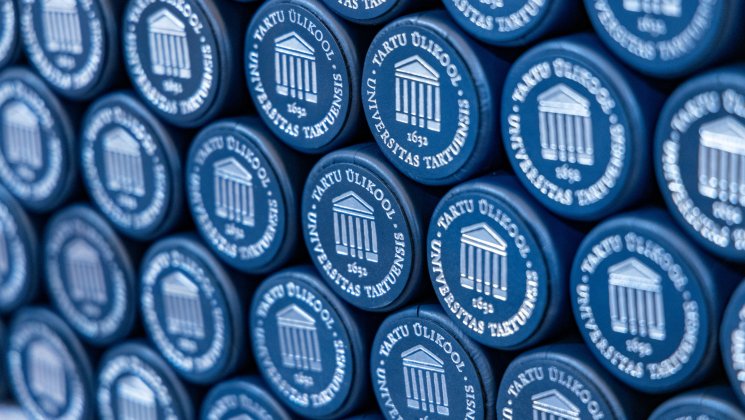-
Faculty of Arts and HumanitiesDean's Office, Faculty of Arts and HumanitiesJakobi 2, r 116-121 51005 Tartu linn, Tartu linn, Tartumaa EST0Institute of History and ArchaeologyJakobi 2 51005 Tartu linn, Tartu linn, Tartumaa EST0Institute of Estonian and General LinguisticsJakobi 2, IV korrus 51005 Tartu linn, Tartu linn, Tartumaa ESTInstitute of Philosophy and SemioticsJakobi 2, III korrus, ruumid 302-337 51005 Tartu linn, Tartu linn, Tartumaa EST0Institute of Cultural ResearchÜlikooli 16 51003 Tartu linn, Tartu linn, Tartumaa EST0Institute of Foreign Languages and CulturesLossi 3 51003 Tartu linn, Tartu linn, Tartumaa EST0School of Theology and Religious StudiesÜlikooli 18 50090 Tartu linn, Tartu linn, Tartumaa EST0Viljandi Culture AcademyPosti 1 71004 Viljandi linn, Viljandimaa EST0Professors emeritus, Faculty of Arts and Humanities0Associate Professors emeritus, Faculty of Arts and Humanities0Faculty of Social SciencesDean's Office, Faculty of Social SciencesLossi 36 51003 Tartu linn, Tartu linn, Tartumaa EST0Institute of EducationJakobi 5 51005 Tartu linn, Tartu linn, Tartumaa EST0Johan Skytte Institute of Political StudiesLossi 36, ruum 301 51003 Tartu linn, Tartu linn, Tartumaa EST0School of Economics and Business AdministrationNarva mnt 18 51009 Tartu linn, Tartu linn, Tartumaa EST0Institute of PsychologyNäituse 2 50409 Tartu linn, Tartu linn, Tartumaa EST0School of LawNäituse 20 - 324 50409 Tartu linn, Tartu linn, Tartumaa EST0Institute of Social StudiesLossi 36 51003 Tartu linn, Tartu linn, Tartumaa EST0Narva CollegeRaekoja plats 2 20307 Narva linn, Ida-Virumaa EST0Pärnu CollegeRingi 35 80012 Pärnu linn, Pärnu linn, Pärnumaa EST0Professors emeritus, Faculty of Social Sciences0associate Professors emeritus, Faculty of Social Sciences0Faculty of MedicineDean's Office, Faculty of MedicineRavila 19 50411 Tartu linn, Tartu linn, Tartumaa ESTInstitute of Biomedicine and Translational MedicineBiomeedikum, Ravila 19 50411 Tartu linn, Tartu linn, Tartumaa ESTInstitute of PharmacyNooruse 1 50411 Tartu linn, Tartu linn, Tartumaa ESTInstitute of DentistryL. Puusepa 1a 50406 Tartu linn, Tartu linn, Tartumaa ESTInstitute of Clinical MedicineL. Puusepa 8 50406 Tartu linn, Tartu linn, Tartumaa ESTInstitute of Family Medicine and Public HealthRavila 19 50411 Tartu linn, Tartu linn, Tartumaa ESTInstitute of Sport Sciences and PhysiotherapyUjula 4 51008 Tartu linn, Tartu linn, Tartumaa ESTprofessors emeritus, Faculty of Medicine0associate Professors emeritus, Faculty of Medicine0Faculty of Science and TechnologyDean's Office, Faculty of Science and TechnologyVanemuise 46 - 208 51003 Tartu linn, Tartu linn, Tartumaa ESTInstitute of Computer ScienceNarva mnt 18 51009 Tartu linn, Tartu linn, Tartumaa ESTInstitute of GenomicsRiia 23b/2 51010 Tartu linn, Tartu linn, Tartumaa ESTEstonian Marine Institute0Institute of PhysicsInstitute of ChemistryRavila 14a 50411 Tartu linn, Tartu linn, Tartumaa ESTInstitute of Mathematics and StatisticsNarva mnt 18 51009 Tartu linn, Tartu linn, Tartumaa EST0Institute of Molecular and Cell BiologyRiia 23, 23b - 134 51010 Tartu linn, Tartu linn, Tartumaa ESTTartu ObservatoryObservatooriumi 1 61602 Tõravere alevik, Nõo vald, Tartumaa EST0Institute of TechnologyNooruse 1 50411 Tartu linn, Tartu linn, Tartumaa ESTInstitute of Ecology and Earth SciencesJ. Liivi tn 2 50409 Tartu linn, Tartu linn, Tartumaa ESTprofessors emeritus, Faculty of Science and Technology0associate Professors emeritus, Faculty of Science and Technology0Area of Academic SecretaryHuman Resources OfficeÜlikooli 18, ruumid 302 ja 304 50090 Tartu linn, Tartu linn, Tartumaa EST0Area of Head of FinanceFinance Office0Area of Director of AdministrationInformation Technology Office0Administrative OfficeÜlikooli 17 (III korrus) 51005 Tartu linn, Tartu linn, Tartumaa EST0Estates Office0Marketing and Communication OfficeÜlikooli 18, ruumid 102, 104, 209, 210 50090 Tartu linn, Tartu linn, Tartumaa EST0Area of Vice Rector for Academic AffairsOffice of Academic AffairsUniversity of Tartu Youth AcademyUppsala 10 51003 Tartu linn, Tartu linn, Tartumaa ESTStudent Union OfficeÜlikooli 18b 51005 Tartu linn, Tartu linn, Tartumaa EST0Centre for Learning and TeachingArea of Vice Rector for ResearchUniversity of Tartu LibraryW. Struve 1 50091 Tartu linn, Tartu linn, Tartumaa ESTGrant OfficeArea of Vice Rector for DevelopmentCentre for Entrepreneurship and InnovationNarva mnt 18 51009 Tartu linn, Tartu linn, Tartumaa EST0University of Tartu Natural History Museum and Botanical GardenVanemuise 46 51003 Tartu linn, Tartu linn, Tartumaa EST0International Cooperation and Protocol Office0University of Tartu MuseumLossi 25 51003 Tartu linn, Tartu linn, Tartumaa EST0Area of RectorRector's Strategy OfficeInternal Audit Office
New technology to help sequence whole genomes from 10,000 gene donors
The Core Facility of Genomics at the Institute of Genomics of the University of Tartu received new PacBio HiFi RevioTM sequencers. These will soon be used to analyse the whole genomes of 10,000 gene donors to the Estonian Biobank.
The three new sequencers were acquired as part of the large-scale TeamPerMed project, the main aim of which is to establish Estonia as the leading research and development centre for personalised medicine in the region. The project is funded by the European Commission and the Estonian government with a total of €30 million.
"Sequencing is a method of analysis that sequences the whole human genome, or 3.2 billion nucleotides. 10,000 new whole genomes will significantly diversify the existing Estonian Biobank, enhancing its value compared to other biobanks across the world,” said Mait Metspalu, Director of the Institute of Genomics and head of the supervisory board of the personalised medicine research and development centre. So far, with the support of Estonian state funding, the genome of nearly 200,000 gene donors has been genotyped or partially analysed and 3,000 DNA samples from the gene pool have been sequenced or completely analysed.
According to Metspalu, based on the whole genome data, it is possible to study the genetic background of various diseases in even more detail, search for new drug targets and more accurately assess the reaction of the human organism to different active substances.
While the whole genomic sequences of the previously analysed 3,000 gene donors have been sequenced using short-sequence technology (sequences 150 nucleotides long), the new sequencers allow sequencing genomes in sequences up to 25,000 nucleotides long. "Sequencing long reads allows better coverage of the whole genome so that longer and more complex repetitive regions and pseudogenes are also sequenced. Analysing long reads also helps to distinguish between two strands of human genomic DNA, and sometimes it is important to know whether DNA variants are located side by side on one strand or come from different strands,” said Paula Ann Kivistik, Vice Manager of Sequencing Core Facility.
The central goal of sequencing 10,000 genomes in the Teaming project is to create the best possible reference map of the variability of Estonian genomes, i.e. the imputation panel. "Such a panel makes it possible to derive, or impute, the missing data to people whose DNA samples have been analysed with much cheaper genotyping technology. This way we can fill in the gaps that are missing and use the data obtained in the provision of personal medicine services,” Metspalu explained.
In addition to sequencing all genomic DNA, according to Kivistik, the PacBio Revio sequencer also provides information about the methylation pattern of DNA strands, or the epigenome. "Methylation plays an important role in human gene regulation and development. Thus, aberrant changes in the methylation status can lead to various diseases and anomalies, including the triggering of tumor processes,” explained Kivistik.
The acquisition of the sequencers is supported by the Ministry of Education and Research in connection with the Teaming for Excellence action under the ‘Widening participation and spreading excellence’ of Horizon Europe.


Genetic adaptations have impacted the blood compositions of two populations from Papua New Guinea
Doctoral defence: Kristi Paron “Child-patient autonomy: interplay between normativity and relationality”


